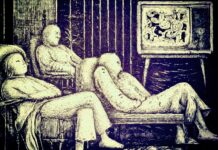A new study published in Lancet Psychiatry challenges the common practice of locking psychiatric wards to prevent patients from attempting suicide or leaving against the advice of their physicians. The study finds that locked doors do not stop these behaviors, and the researchers speculate that locked wards may even be worse for patient safety.

Christian Huber, a psychiatrist and lead author of the study, explains:
“These findings suggest that locked-door policies may not help to improve the safety of patients in psychiatric hospitals, and are not generally successful in preventing people from absconding. In fact, a locked-door policy probably imposes a more oppressive atmosphere, which could reduce the effectiveness of treatments, resulting in longer stays in the hospital. The practice may even lend motivation for patients to abscond.”
The large 15-year observational study out of Germany examined records from 21 inpatient psychiatric hospitals between 1998 and 2012. The researchers analyzed 145, 738 cases from hospital wards with different policies (locked doors, partly locked, and open) and compared the rates of suicides, suicide attempts, and leaving without permission (with and without returning).
According to their analysis, suicide attempts were actually less common on open wards than on locked wards, and the risk for completed suicides did not appear to differ significantly between ward types. Locking patients in the wards also did not significantly reduce the rate at which patients left (absconding) without return when compared to open wards.
“Absconding might occur when the ward climate is more restrictive, such as on locked and partly locked wards, strengthening the patients’ motivation to regain personal freedom and leave the ward when the possibility arises,” the researchers write.
“Open and day clinic wards might successfully counter their reduced ability to retain patients physically by providing an improved therapeutic atmosphere, and clinicians should explore how they can adapt—for example—day clinic settings to the needs of severely ill patients.”
In an accompanying editorial, Oxford psychiatry professor Tom Burns adds:

“Throughout western psychiatry, we are witnessing a shift to ever more compulsion and control. National variations seem to reflect local customs and tradition, rather than any demonstrated differences in patient characteristics and needs. At its most basic, this increased compulsion reflects a casualness about patients’ rights that calls for urgent attention–virtually every national code of practice is committed to the concept of the least restrictive alternative. This increase in control might also indicate a more worrying trend–a neglect of attention to establishing trusting relationships with troubled and severely mentally ill individuals. If we lose the emphasis on this core skill from our training and practice, it could be very difficult to re-establish. Therapeutic engagement and continuity of care need to move back up our profession’s priorities.”
Note: Psychologist James Coyne has criticized this study on his “Mind the Brain” blog for PloS, arguing that the data doesn’t support the stated conclusions.
You can read his criticism here →
****
Huber, C.G., Schneeberger, A.R., Kowalinski, E., Fröhlich, D., von Felten, S., Walter, M., Zinkler, M., Beine, K., Heinz, A., Borgwardt, S. and Lang, U.E., 2016. Suicide risk and absconding in psychiatric hospitals with and without open door policies: a 15 year, observational study. The Lancet Psychiatry. (Abstract)















It was anxiety attacks that lead me to ERs and inpatient wards and the only thing the locked doors did for me was turn the whole place into the enemy.
How are you feeling today ?? Well I feel the best thing to do is give you what ever answer I think will make this undetermined length of incarceration come to an end as quickly as possible. Sorry I came to your ER but $2 worth of Ativan would have pulled me out of it and I don’t need this crap.
The worst had to be the hospital run by “Universal Health Services” it may sound like a typical generic bad review on Yelp but that place really was just holding people hostage to collect insurance money. People being told they were going home until I guess someone talks the insurance company into paying more money and they don’t. The same people wanting to keep the beds full and profits flowing were the ones deciding who is sick and who is well. Total conflict of interest that made Universal Services about a billion dollars last year and CEO Allan miller paid himself over 10 million dollars.
I look up to smart businessmen make millions that’s great but Allan Miller is a kidnapper who engages in insurance fraud what that place did to me on his watch.
Locked doors ruin the therapeutic alliance that’s a given but with billions in profit on the line I don’t think the psychiatric industry really cares. No one would stay in that UHS hellhole @ $1000 a day without locked doors to keep its “customers” inside.
Report comment
UHS Hellholes > https://watchinguhs.wordpress.com/
Report comment
I agree, cat, locked doors are all about defrauding insurance companies out of money. “… a locked door policy probably imposes a more oppressive atmospher,” you think? Locked doors are being used by the criminal doctors, like the one who medically unnecessarily held me against my will so he and his Advocate Good Samaritan partners in crime could defraud my health insurance company out of $30,000.
One of the criminal doctors was later finally arrested by the FBI for doing the same thing and worse to lots of Medicare / Medicaid patients at a smaller hospital, and defrauding the state out of a lot of money for unneeded “snowings” and “tracheotomies.”
https://www.justice.gov/usao-ndil/pr/oak-brook-doctor-convicted-kickback-scheme-sacred-heart-hospital
And absolutely, when the insurance company refuses to pay any more, the so called “patient” is set free, but not until that time. Thank God it only took my insurance company 2 1/2 weeks to end the tortuous forced “snowings.” Forced treatment needs to be outlawed.
Report comment
My son (who is incarcerated for up to life in a psychiatric hospital) told me after I read this article to him…’When you treat people like damaged children, they will tend to act like damaged children because they are brainwashed into believing they are indeed damaged and less than human. When you treat people with respect and act like you really care rather than acting like a cop and a punisher, then people will tend to behave like adults who understand they deserve to be respected.’
Report comment
How anyone could believe that locking another human being up and drugging them could be “therapeutic” is absolutely beyond me.
The day I was locked up I frantically searched for an unlocked door. I, a woman, was placed with high dependency males, who were heavily drugged. One threatened me sexually, another took my food and water. When night time came, as I lay cringing and terrified on my bed, a large male entered my room and announced he was my night nurse. I was the only female in an unsafe, all male hell.
That night I entered my first (and only) psychotic state. I fell through the pits of hell. I had failed both the gods and the devil and was destined to be the butt of every type of abuse for eternity. I was too scared of what my jailers (ie the psychiatrists running the hospital) would do to cry out or move, so I fell silently, endlessly, and alone. It was revealed to me that the purpose of the hospital was to make me totally powerless so I could never function in society again as a human being, but would be forced to live like a rat, hiding and scavenging.
Now….what makes anyone think I would co-operate with this aim? What makes anyone think that I would give these tormentors any information that would help them achieve their aims?
My tiny fragment of remaining sanity was directed to getting myself the hell out of there with as much of my apparently-totally-evil-self in tact as possible. ‘Twas difficult, given the drugs they forced on me, and the abuse and violence of the place, but 6 weeks later they let me go.
A helpful experience? Therapeutic? Shortly after I very nearly succeeded in suicide.
Yet such practices continue throughout the world, and from what I see, the good doctors – highly trained psychiatrists – continue to be surprised when people are not totally delighted with their treatment….after all, being terrified into a psychosis and then drugged is all “for your own good”.
Report comment
The role of healer/helper and jailer/drugger are mutually exclusive.
Report comment
This study should be a caution to all those AOT/reduced civil rights advocates out there. But of course, it will be ignored, because its conclusions don’t fit the desired narrative of “lock up the dangerous crazies and drug them into submission!” Or should I say, “Provide ‘treatment’ to those poor crazies and drug them into submission!” Comes to about the same thing.
—- Steve
Report comment
Damn locked hospitals are real nightmares for some people, I was scared when they came at me with the needle threat, that was scary the idea of some nerve toxin in my blood can’t get it out and the assault that goes with it but the anger and hatred towards the people mistreating me helped get me through my inpatient nightmare.
I had a friend in there that really had it worse, he did not have the anger element of it and that violent environment combined with the locked doors can’t run to safety had him in a 24/7 panic. He told me he ended up there from staying awake a few days drinking coffee and chain smoking. He also was very upset about being watched with those cameras everywhere, I took a crayon and fouled the lens of the camera in the day room eating room to prove no one was looking at it. Maybe that helped a little but that dude could not relax.
By the telephones in this place the same story played out over and over again, calls to family “get me out of here” followed by the clueless families telling them they need to stay to get “help” and of course that followed by the usual escalation FU this is not help I hate you for letting them do this to me I hate you.
I remember this guy calling his family and everything he told them was true, the place was a dangerous nightmare and that locked door no where to run environment was anything but “help”.
I honestly can’t think of anything to add to a persons anxiety or paranoia that would do a better job of making it worse then adding “your trapped” to the situation. I really can’t.
Report comment
How much do these guys sound like 1950s anthropologist speaking about the “natives”? These types of “etic” perspectives are all well and good but they will never truly understand it without an insiders perspective. And I don’t mean what they tell the doctor.
What about people who actually want the security of the locked ward? In this sense what is oppressive to some, is precisely what the other requires. And I do understand how people are kidnapped and Stockholmed into these places, but if they say without any threats or coercion that it’s what they want?
I know I don’t like to be locked up, and am thus marked for Degradation and Humiliation therapy until I comply. But I also saw one guy trying to break IN to the locked ward one day when he was refused admission so. I mean really, if you ever needed evidence that someone wasn’t well, trying to break into a mental institution is a big clue lol
Report comment
Being coercive lay put under psychiatry would increase, rather than decrease, the risk of suicide. Psychiatry often abuses people. Mental “illnesses” are not real. Psychiatry is used more for repressively controlling people than healing them. People do better when they are not under the “care” of psychiatry.
Report comment
Exactly. Very few psychiatrists care about creating a real therapeutic relationship with the people under their power. Healing takes place through knowing that someone truly cares about your welfare and is willing to walk with you in finding healing and well-being. Psychiatrists demand compliance and this does not lead to healing. But of course who am I to say anything since I’m not an “expert” on all of this like psychiatrists are.
Report comment
Locked wards cost a lot more per day than alternative settings, and yet the government will not support and fund alternative settings. I suspect that most people who end up in state “hospitals” do not have insurance. They do have Medicare and Medicaid. So the government ends up spending about $1,000 per day per person on locked wards. Alternative settings cost about $250 per day so go do the math. Of course.
Report comment